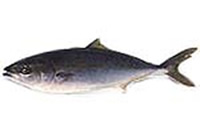![]()
![]()
Kagawa Prefecture is located on the northeast side of the island of Shikoku and borders the prefectures of Tokushima to the east and south and Ehime to the west. Japan’s smallest prefecture, Kagawa covers an area of 1,876.55km2. The Sanuki Mountain Range runs across the south and the Sanuki Plain lies on the north along the Seto Inland Sea National Park, which was established in 1934 as Japan’s first national park. The Inland Sea is renowned for its scenic beauty and myriad islands, and the prefecture’s coast extends for about 722km. The climate is mild throughout the year with low rainfall.
Kagawa is home to Ritsurin Garden, which was designated a Special Place of Scenic Beauty in 1953.The spacious garden was first established as the site of the feudal lord’s private villa and is highly regarded by overseas tour guides and garden magazines. It consists of a traditional Japanese promenade garden with six ponds and thirteen hills, and a semi-western style garden with many flowering trees. From 2012 a small boat takes an excursion in the south pond. People can enjoy a different view of the garden listening to a boatman’s story.
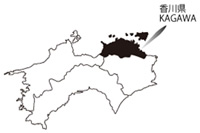
 Seto Ohashi Bridge
Seto Ohashi Bridge
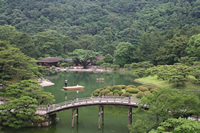 Ritsurin Garden
Ritsurin Garden
The island of Shikoku is encircled by a 1200km-long pilgrimage route of 88 temples associated with the 8th century Buddhist priest Kobo Daishi. Twenty-three of these temples are situated in Kagawa, from Unpenji (Temple 66) to Okuboji (Temple 88). The year 2014 marked the route’s 1200th anniversary. The route represents a unique cultural and historical heritage, and efforts are being made to register it as a UNESCO World Heritage Site and thereby ensure its continuation.
Kagawa is famous for its wheat noodles known as “Sanuki Udon”, so much so that the prefecture recently dubbed itself the “Udon Prefecture” as part of a successful PR campaign that made the region a household name. But Kagawa is famous for far more than these delicious noodles. The prefecture is particularly proud of its long tradition of promoting top quality arts and handicrafts, such as Sanuki lacquer ware. It also boasts many fine works by contemporary artists and architects.
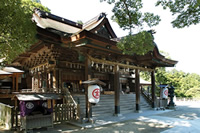 Konpira Shrine
Konpira Shrine
 Pilgrim
Pilgrim
Kagawa boasts many fine works by contemporary artists and architects such as Genichiro Inokuma and Isamu Noguchi and have offered such artists the place of their creative activity. Kagawa Prefectural Office East Wing, Marugame Genichiro-Inokuma Museum of Contemporary Art, Chichu Museum in Naoshima Island – there are many buildings and architecture designed by famous architects that attract a great number of visitors. The Setouchi Triennale, a festival of contemporary arts, has helped recognition of Kagawa as an art prefecture.
The diverse landscape of Kagawa, with its many islands and rural scenes, is a work of ‘art’ in itself. By coupling the natural scenery with works of manmade art and architecture, the prefecture is further enhancing the region’s beauty and firmly establishing itself as a magnet for art lovers.
 Setouchi Triennale
Setouchi Triennale
Megijima Island (Seagulls’ Parking Lot)
 Sanuki Lacquer Ware
Sanuki Lacquer Ware
【Seto Philharmonic Orchestra】
The Seto Philharmonic Orchestra, which will accompany the pianists in Round 3 and the Final Round, was the first professional orchestra to be established in Shikoku. Affectionately known as the “Seto Phil”, it was launched in November 2001 to promote local musical talent and stimulate musical culture. The Seto Phil performs at many events both in Kagawa and elsewhere.
Prefectural Emblem
The emblem design, which was adopted on October 1, 1977, is a stylized version of the prefecture’s first syllable in Japanese "カ". It represents the distinctive cone shape of the area’s mountains, as well as the shape of an olive leaf, which is not only a symbol of peace but also the prefectural tree. The design symbolizes the Kagawa’s rich natural environment and its dedication to progress.
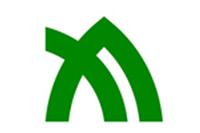
Udon Prefecture Emblem
This emblem was developed for the popular PR campaign in which Kagawa was dubbed the “Udon Prefecture”. The slogan was “Udon Prefecture and much more than that”. The design, of course, features a bowl of noodles. A well-known Japanese actor and Kagawa native was (fictionally) appointed “Vice-Governor of Udon Prefecture” in 2011, attracting nationwide attention, and this emblem was used as his official badge.

Prefectural Flower/Tree: Olive
The olive belongs to the evergreen family Oleaceae. Its small white flowers blossom in the early summer. In Europe, it is a symbol of peace and well-being. Its selection as the prefectural flower was announced during the first program aired at NHK Takamatsu Station in 1954. On September 10, 1966, the olive was also chosen as the prefectural tree by local citizens through a public campaign to promote the planting of trees and greenery.
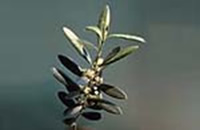
Prefectural Bird: Hototogisu (Little Cuckoo)
The little cuckoo is common in Kagawa and is featured in many songs and poems. Kagawa is the favorite breeding ground of this migratory bird. Locals appreciate the bird’s role in keeping down pests such as caterpillars. It was designated as the prefectural bird on May 10, 1966.
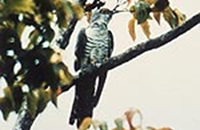
Prefectural Animal: Japanese Deer
Japanese deer live on the island of Shodoshima. They are valued both as subjects of academic research and as tourism resources. The deer’s elegant appearance perfectly represents the people of Kagawa. The Japanese deer was designated as the prefectural animal on May 10, 1966.
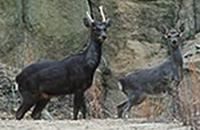
Prefectural Fish: Hamachi (Yellowtail)
The first fish-farming technology in Japan was developed in Kagawa in the mid-1920s. The yellowtail is a key species in Kagawa's fisheries industry. In Japan, the fish is called by different names at different stages of its growth, including mojako, tsubasu and hamachi. It was designated as the prefectural fish on November 7, 1995.
